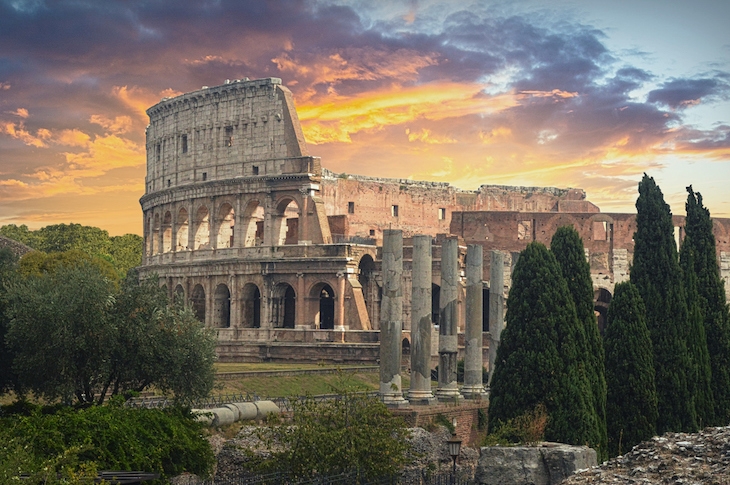Why did the Roman Empire collapse? It’s a question that’s been puzzling writers ever since Edward Gibbon wrote The History of the Decline and Fall of the Roman Empire in the late 18th century. One classicist — a German, inevitably — bothered to count up all the various hypotheses for the fall, and came up with 210.
The conventional explanation is that, in 410 AD, King Alaric and his Visigoths sacked Rome. Across the Empire, from Hadrian’s Wall to Africa, legionaries folded their tents and deserted their posts.
Several centuries of self-indulgent, over-reaching and in-fighting emperors had done for the whole shooting match, leaving the Eastern Roman Empire to stumble on until the fall of Constantinople in 1453. And so Roman history came to a full stop.
But wait a minute! Here comes Kyle Harper, professor of classics at Oklahoma university, with a delicious new theory. It wasn’t just lusty emperors and barbarian vandals who brought down the Empire, he says. It was climate change, solar cycles, volcanoes and rampaging plague that conspired to destroy the biggest imperial project the world has ever seen. Harper argues his case brilliantly, with deep scientific research into weather, geology and disease. This engaging book is at the egghead end of the market, not one for the kids or fans of Bromans.
Harper doesn’t refute Gibbon’s reasons for the fall, and he agrees with Gibbon’s famous verdict on the Empire’s most prosperous period, between 96 and 180 AD. That, he says, was when the Romans achieved a kind of favourable imperial equilibrium — not too big and not too small. By 650, those heady days were long gone: the population of the Mediterranean basin, which had been 75 million, collapsed to half that; Rome, once home to 1,000,000 at its ancient height, was now inhabited by only 20,000.
It was a stratospheric fall. But Gibbon’s overreach explanation could only be part of it, says Harper; climate change was crucial too. The period from 200 BC to 150 AD — when the Roman project was at its most healthy — also coincided with what he calls Roman Climate Optimum, when the weather warmed up. Pliny the Elder, writing in the first century AD, described how beech trees, which used to grow only in the lowlands, started climbing up mountains as the temperature rose. Olives and vines were grown further and further north. The Empire became a giant greenhouse.
The weather deteriorated in 150–400 AD — the ‘Roman Transitional Period’ — and hit temperature lows in the ‘Late Antique Little Ice Age’, from 450–700 AD, when the Empire fell apart.
The worst aspects of climate change, Harper maintains, hit the Empire just as it was blighted by its most serious bouts of disease. In 165 AD, the Antonine plague, probably caused by smallpox, struck. In 249 AD, an unknown type of pathogen followed. Then, in 541 AD, the first great pandemic of Yersinia pestis, which causes bubonic plague, arrived and lingered for more than two centuries.
Even the least of these catastrophes, the Antonine plague, killed 7,000,000, according to Harper’s methodical calculations. Compare this to the bloodiest day in Roman military history, the Battle of Adrianople in 378 AD, between the Eastern Romans and Goths, when 20,000 died. In other words, disease killed more people than weapons — which remained the case in all conflicts until the American Civil War.
The natural disasters came thick and fast. Drought and pestilence in the mid 3rd century, along with political instability, led to a mini-collapse — sometimes called the ‘first fall’ — of the Empire. In Egypt in 244 AD, the Nile, a crucial agricultural source, failed to rise and irrigate neighbouring fields, and was weak in the following two years.
That double blow of bubonic plague and the mini ice age in the sixth century AD did the rest. The year 536 AD, when clouds blotted out the sun thanks to a huge volcanic eruption in the northern hemisphere, was dubbed ‘the year without summer’. And so, by 626 AD, the Persians were at the walls of Constantinople.
It is an enticing theory, and Harper is a serious historian. But it’s hard not to think that this is an environmental history, written at a time when the environment is at the forefront of western minds. He over-eggs his theory, and cherry-picks his impeccably researched statistics, arranging them in neat order behind it.
Great natural disasters must have contributed to the fall of the Roman Empire; but they must also have affected its rise. In the end, man is eternally fallible — and no empire lasts for ever, whatever the weather.






Comments